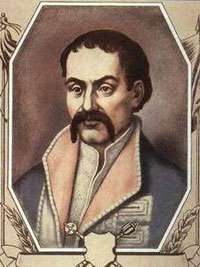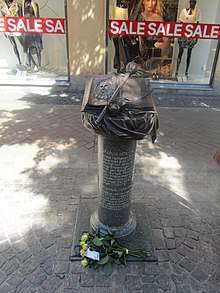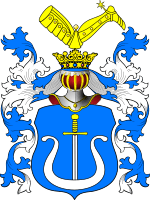Pylyp Orlyk
Pylyp Stepanovych Orlyk (Ukrainian: Пилип Степанович Орлик, Polish: Filip Orlik) (born on October 11, 1672 in Kosuta, Ashmyany county, Polish-Lithuanian Commonwealth (today in Vileyka Raion, Belarus), died on May 26, 1742 in Jassy, Principality of Moldavia (today Iaşi, Romania) was a Zaporozhian Cossack starshyna, Hetman of Ukraine in exile, diplomat, secretary and close associate of Hetman Ivan Mazepa. Founder of the first Constitution in Europe.
Pylyp Orlyk Пилип Орлик | |
|---|---|
 | |
| Hetman in exile | |
| In office April 5, 1708 – May 24, 1742 | |
| Preceded by | Ivan Mazepa |
| Personal details | |
| Born | October 11, 1672 Kosuta, Polish-Lithuanian Commonwealth (today Vileyka Raion, Belarus) |
| Died | May 26, 1742 Jassy, Principality of Moldavia (today Iaşi, Romania) |
| Spouse(s) | Hanna Hertsyk |
Biography
Pylyp Orlyk was born in the village of Kosuta, Ashmyany county, Grand Duchy of Lithuania (Vileyka district of modern-day Belarus), in a family of Czech-Belarusian origin.[1]
Orlyk first studied at the Jesuit college in Vilnius and until 1694 at Kyiv Mohyla Academy. In 1698 he was appointed secretary of the consistory of Kiev metropolia. In 1699 he became a senior member of Hetman Ivan Mazepa's General Military Chancellery and 1706 was appointed general chancellor and at that position he was Mazepa's closest aide, facilitated Mazepa's secret correspondence with the Poles and Swedes, and assisted Mazepa in his efforts to form an anti-Russian coalition.[2]
Hetman in exile

After the Battle of Poltava in 1709, he escaped together with Hetman Ivan Mazepa and king Charles XII of Sweden to Bender in the Principality of Moldavia, where Mazepa soon died. Pylyp Orlyk was then chosen as a Hetman in exile by the cossacks and the Swedish king Charles XII. While in Bender Orlyk wrote one of the first state constitutions in Europe. This Constitution of Pylyp Orlyk was confirmed by Charles XII and it also names him as the protector of Ukraine.
Between 1711 and 1714, together with Crimean Tatars and small groups of Cossacks, Orlyk carried out unsuccessful raids into Right-bank Ukraine. Afterwards, Pylyp Orlyk now together with several other cossacks followed the Swedish king Charles XII to Sweden via Vienna and Stralsund. Orlyk with his family and about 40 other Cossacks arrived in Ystad, Sweden in late November 1715. After some months in Ystad they lived in the city of Kristianstad for some years. Orlyk and his family left Stockholm in 1720 but as late as 1747 his widow and children received financial support from the Parliament of Sweden. From Sweden Orlyk first went to Hamburg, Hannover, Prague, Wrocław and Kraków, where he left his family to stay in a monastery. Orlyk went on to France and in 1722 he arrived in Iaşi in Ottoman Moldavia in order to organize an alliance against Russian Empire. From there he went on to Thessaloniki and from the mid-1730s he is known to have lived in Budjak. He died 1742 in Jassy, Principality of Moldavia (today Iaşi, Romania).[3]
Orlyk wrote numerous proclamations and essays about Ukraine including the 1710 Constitution of Pylyp Orlyk.[4]
In his history of Salonica Mark Mazower says
After years fighting against the Muscovite tsars, Orlyk fled first to Sweden, and then passed through central Europe to the relative safety of the Ottoman lands. On 2 November 1722… the fifty-year-old Orlyk was ordered by the Porte to Salonica. There this cultivated and warm-hearted man spent no less than twelve years in exile, watching the twists and turns of European politics from the sidelines while his impoverished wife remained in Cracow and his eight children were dispersed throughout Europe. Only in March 1734 was he released, thanks to French intervention, and allowed to move north; still trying to organize an uprising in the Ukraine, he died in poverty nine years later. Orlyk's misfortune has proved to be the historian's gain, for from the day of his arrival he kept a diary which offers a unique insight into the eighteenth-century city… His urgent scrawl gives access not only to his voluminous political correspondence, most of which – in Latin, French, Polish and Ukrainian — was duly copied into his journals, but also to the rigours of daily life in his place of exile. The misbehaviour of his loutish servants, the local fare, his bag after a day's shooting in the plains, stories told him by tailors, interpreters and bodyguards enliven its pages. Jesuits, consuls, doctors, spies and the Turkish judges and governors who ran the city all encountered the busy exile. Most of the time, he lived well, considering his predicament...[5]
Memory

In 2011 a monument dedicated to Pylyp Orlyk was erected in Kristianstad, Sweden on a building Ukrainian hetman lived in 1716–1719 years to celebrate tercentenary of Pylyp Orlyk's constitution. The authors of the monument are Boris Krylov and Oles Sydoruk.
Family
Pylyp Orlyk | |
|---|---|
| Coat of arms |  |
| Noble family | Orlyk |
Pylyp Orlyk married Hanna Hertsyk in the mid-1690s. She was of Jewish descent, a daughter of the colonel Pavlo Semenovych Hertsyk (a close ally of Mazepa) of the Poltava regiment. Pylyp and Hanna had eight children. They were:[6][7]
- Anastasiya Orlyk (1699 – 1728) – born in Poltava - married the Swedish nobleman and officer Johan Stenflycht (1681–1758) in 1723. They had two sons:
- Carl Gustaf (1724 – 1758) – colonel in the French regiment Royal Pologne.
- Filip (1726 – 1739) – died in Hamburg.
- Grégoire Orlyk (French: du Comte Grégoire Orlyk) (* November 5, 1702 — † November 14, 1759)- born in Baturyn, Ukraine. His godfather was Hetman Ivan Mazepa. He studied at Lund University (1717–1718). After leaving Sweden in 1720 he first lived with his mother in Kraków, Poland. He later became a Lieutenant General in France where he called himself Comte d'Orlik. Although he kept the contact with Sweden and in 1742 he also visited Stockholm. In 1747 he married a French noblewoman, but they didn't have any children. He was killed in 1759 at the Battle of Minden in Germany where he also is buried.
- Mykhailo Orlyk (1704 – ?) – born in Baturyn, Ukraine. His godfather was Hetman Ivan Mazepa.
- Varvara Orlyk – born in Baturyn, Ukraine. Her godfather was Hetman Ivan Mazepa.
- Yakiv Orlyk (1711 – ?) – born in Bender, Ottoman Empire. His godfather was king Charles XII of Sweden.
- Marta Orlyk (1713 -?) – born in Bender, Ottoman Empire. Her godfather was king Stanisław Leszczyński of Poland.
- Maryna Orlyk (1715 – ?) – born in Altefähr, Rügen, Swedish Pomerania. Her godparents were king Charles XII of Sweden's sister Ulrika Eleonora and king Stanisław Leszczyński of Poland.
- Kateryna Orlyk (November 5, 1718 – ?) – born in Kristianstad, Skåne, Sweden and probably died already in 1719.
References
- "Pylyp Orlyk roots." Mirror Weekly. October 28, – November 3, 2006. Accessed September 2, 2007.
- Encyclopedia of Ukraine
- Alfred Jensen: Mazepa, p.174–194. Lund 1909.
- 300th anniversary of first Ukrainian constitution written by Pylyp Orlyk being celebrated, Kyiv Post (April 5, 2010)
- Mark Mazower, Salonica: City of Ghosts, p.107. Vintage Books, 2004.
- Alfred Jensen: Mazepa, p.174–194. Lund 1909.
- Bertil Häggman: "Son til ukrainsk 1700-talsstatschef med skånsk anknytning studerade i Lund." Lundagenealogen 2008:1.
- (in French) Jean-Benoit Scherer, Annales de la Petite-Russie, ou Histoire des Cosaques-Saporogues et des Cosaques de l'Ukraine (Adamant Media Corporation, 2001)
External links
- Minsk honors Ukrainian hetman, born in Belarus (in Belarusian)
- Taras Chuhlib, The Belarusian roots of hetman Pylyp Orlyk, Zerkalo Nedeli (Mirror Weekly), October 28 – November 3, 2006, in Russian and in Ukrainian.